Government of Carlos Quintanilla, 1939–40
Carlos Quintanilla assumed office as the interim 37th President of Bolivia on 23 August 1939, and his mandate ended on 15 April 1940. A member of the traditional, establishment officer class, General Carlos Quintanilla assumed control of the presidency on an interim basis following the suicide of his predecessor, Germán Busch. Though he tried to extend his mandate, Quintanilla eventually called for new elections to be held on 10 March 1940 with his mandate coming to an end upon the inauguration of the winner of that election, Enrique Peñaranda.[1]
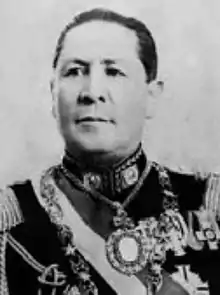 | |||
| Interim Presidency of Carlos Quintanilla 23 August 1939 – 15 April 1940 | |||
| Seat | Palacio Quemado | ||
|---|---|---|---|
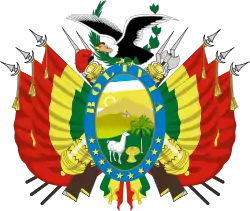 |
|---|
| This article is part of a series on the politics and government of Bolivia |
|
|
Three days after taking office, on 26 August 1939, Quintanilla formed his first and only cabinet in his short mandate, constituting the 101st national cabinet of Bolivia.[2]
Cabinet Ministers
Cabinet of Bolivia Interim Presidency of Carlos Quintanilla, 1939–1940 | |||||||
|---|---|---|---|---|---|---|---|
| Office | Name | Party | Term | Prof. | N.C[lower-alpha 1] | P.C[lower-alpha 2] | |
| President | Carlos Quintanilla | Military | 23 August 1939 – 15 April 1940 | Mil. | – | – | |
| Vice President | Office vacant 23 August 1939 – 4 December 1939 | ||||||
| Office blank 4 December 1939 – 15 April 1940[lower-alpha 3] | |||||||
| Minister of Foreign Affairs and Worship (Chancellor) |
Alberto Ostria Gutiérrez[4] | N/A | 26 August 1939 – 1 October 1941 | Law. | 101 | 1[lower-alpha 4] | |
| Minister of Government and Justice |
Vicente Leyton | N/A | 18 March 1939 – 15 April 1940 | Law. | 100[lower-alpha 5] | 3[lower-alpha 6] | |
| Minister of National Defense | Angel Ayoroa | Military | 26 August 1939 – 15 April 1940 | Mil. | 101 | 1 | |
| Minister of Finance and Statistics |
Fernando Pou Mont | N/A | 26 August 1939 – 15 April 1940 | Law. | 101 | 1 | |
| Minister of Industry and Commerce |
José E. Anze | N/A | 26 August 1939 – 15 April 1940 | – | 101 | 1 | |
| Minister of Mining and Petrol |
Felipe Manuel Rivera | Military | 26 August 1939 – 15 April 1940 | Law. | 101 | 1 | |
| Minister of Public Works and Communications |
Rubén Terrazas | PRG | 26 August 1939 – 15 April 1940 | Law. | 101 | 1 | |
| Minister of Education,
and Indigenous Affairs |
Bernardo Navajas Trigo | PL | 12 August 1938 – 15 April 1940 | Law. | 100[lower-alpha 5] | 3[lower-alpha 6] | |
| Minister of Work and Social Security |
Demetrio Ramos | Military | 26 August 1939 – 15 April 1940 | Mil. | 101 | 1 | |
| Minister of Health and Hygiene |
Alfredo Mollinedo | PSU | 22 August 1938 – 15 April 1940 | Dr. | 100[lower-alpha 5] | 3[lower-alpha 6] | |
| Minister of Agriculture, Colonization, and Immigration |
Carlos Salinas Aramayo | N/A | 26 August 1939 – 15 April 1940 | Law. | 101 | 1 | |
Composition
In his short mandate, Carlos Quintanilla only formed one ministerial cabinet. Of the 11 ministers, three (Minister of Government Vicente Leyton, Minister of Education Bernardo Navajas Trigo, and Minister of Health Alfredo Mollinedo) were direct holdovers from the Busch cabinet. In addition, Felipe Manuel Rivera, who had been Minister of Defense under Busch up until his death, was made Minister of Mining and Petrol, a position he had also held during the Busch administration. The new Minister of Defense replacing Rivera was Angel Ayoroa who had also served in the Busch cabinet as Minister of Industry.
On the same day as the establishment of the new cabinet, the Ministry of Propaganda was abolished.[5] Notably, the office of the vice presidency was also abolished through a constitutional amendment on 4 December 1939. This decision came after Busch's vice president Enrique Baldivieso had attempted to claim his constitutional succession to the presidency.
The term of the Quintanilla cabinet ended on 15 April 1940 upon the inauguration of Enrique Peñaranda. Foreign Minister Alberto Ostria Gutiérrez would be the only direct holdover into the Peñaranda administration. Minister of Labor Demetrio Ramos would also remain in the Peñaranda administration but would be switched from Minister of Labor and made Minister of Defense and later Government. Finally, Minister of Public Works Rubén Terrazas would return as Minister of Education in 1942 while Minister of Agriculture Carlos Salinas Aramayo would be appointed Foreign Minister in 1943.
Gallery
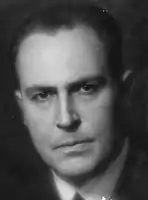 Alberto Ostria Gutiérrez – Chancellor
Alberto Ostria Gutiérrez – Chancellor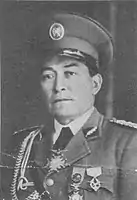 Angel Ayoroa – Minister of Defense
Angel Ayoroa – Minister of Defense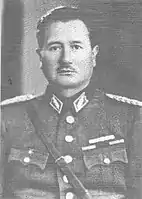 Felipe Manuel Rivera – Minister of Mining and Petrol
Felipe Manuel Rivera – Minister of Mining and Petrol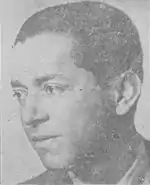 Rubén Terrazas – Minister of Public Works and Communications (PRG)
Rubén Terrazas – Minister of Public Works and Communications (PRG)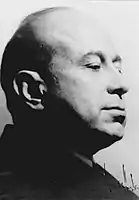 Bernardo Navajas Trigo – Minister of Education (PL)
Bernardo Navajas Trigo – Minister of Education (PL) Demetrio Ramos – Minister of Work and Social Security
Demetrio Ramos – Minister of Work and Social Security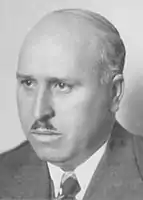 Carlos Salinas Aramayo – Minister of Agriculture, Colonization, and Immigration
Carlos Salinas Aramayo – Minister of Agriculture, Colonization, and Immigration
Notes
- Denoting which national cabinet the minister was originally a part of
- Denoting which presidential cabinet the minister was originally a part of
- Following the suicide of Germán Busch, Vice President Enrique Baldivieso tried to convince the military chiefs to allow him to assume the presidency. Instead however, General Quintanilla was soon elevated to the position on the basis that since Busch had declared himself dictator four months prior, the constitutional order was thus null and void. Quintanilla would later abolish the office of the vice presidency entirely through a constitutional amendment on 4 December 1939.[3]
- Held over into the Peñaranda cabinet
- Originally a member of the 100th national cabinet of Bolivia
- Originally a member of the third Busch ministerial cabinet
References
- "Bolivia: Ley de 14 de abril de 1940". www.lexivox.org. Retrieved 29 January 2021.
- "DECRETO SUPREMO del 26 de Agosto de 1939 – 2 » Derechoteca.com". www.derechoteca.com. Retrieved 29 January 2021.
- "Bolivia: Decreto Ley de 4 de diciembre de 1939". www.lexivox.org. Retrieved 29 January 2021.
- "canciller". web.archive.org. 7 April 2014. Retrieved 24 January 2021.
- "DECRETO SUPREMO del 26 de Agosto de 1939 – 1 » Derechoteca.com". www.derechoteca.com. Retrieved 29 January 2021.
Bibliography
- Gisbert, Carlos D. Mesa (2003). Presidentes de Bolivia: entre urnas y fusiles : el poder ejecutivo, los ministros de estado (in Spanish). Editorial Gisbert. p. 344.